Romantic, mysterious, soothing, and radiant, moonlight has its own special qualities. We explore how we perceive the night under a bright Moon.
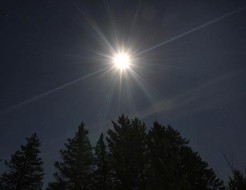
Bob King
A moonlit stroll is starkly different from a walk in the sunshine. Moonlight's dark, spooky quality contrasts with the clarity of sunlight. And while it may not grow hair on your face, we can't help but notice the blacker shadows, blurred details, and lack of color in the landscape on a moonlit night.
We peer into the gloom straining to see what's there, but lacking the usual visual cues, we're liable to fill in the darkness with our imagination. Is that Bigfoot up ahead or the neighbor's garbage can?
For these reasons, it's often used in scary movies where exaggerated contrasts under studio moonlight create an unfamiliar landscape where anything can happen, including romance.
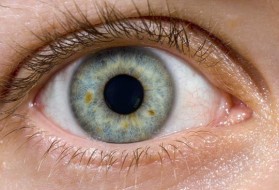
Wikipedia
For many of us, both moonless and moon-full nights simply aren't bright enough to stimulate the retina's cone cells responsible for detail and color vision. At low light levels, a different group of light-sensing cells called rods go to work.
Rod cells are seriously sensitive, able to detect a single photon of light, but they lack the ability to see color and detail. On a moonless night away from city lights, the nightscape is painted in shades of gray, charcoal black, and bony whites.
Things aren't so simple when the Moon is out, something you can see for yourself this week as the gibbous Moon waxes to full by Sunday night.
Moonlight is essentially sunlight reflected from the Moon's surface. Makes sense. Because that surface is asphalt-black, it returns only 11% of the light lavished upon it by our star. Light striking the Moon's ubiquitous pulverized dust is actually somewhat redder than sunlight, but we don't see this with our eyes because it's offset by all the other colors contained in moonlight. A high-riding Moon gleams with silvery-white radiance.
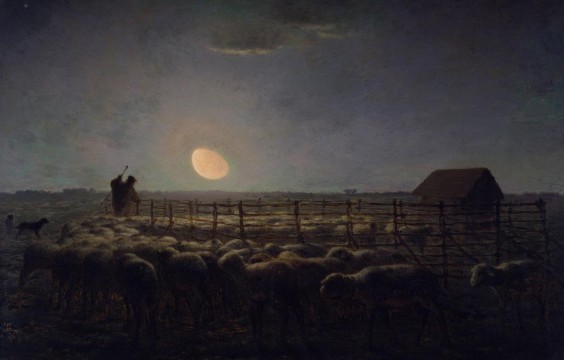
Walters Art Museum
But what about the landscape below? As we touched on earlier, a casual glance outdoors on a bright moonlit night reveals a world of grays. Color doesn't jump to mind, except for maybe blue. Blue? You've probably noticed a favorite trick used by painters and movie directors alike to simulate moonlight. Add blue! With movies, it's done by taping in the daytime with a filter over the lens.

Bob King
Rods may be colorblind, but they're most sensitive to blue-green light. Could this be the reason behind moonlight blues? In their paper titled Modeling Blue Shift in Moonlit Scenes by Rod Cone Interaction, Saad M. Khan and Sumanta N. Pattanaik (University of Central Florida) hypothesize that rod signals "bleed" into adjacent blue cones to create the illusion of blue under a moonlit sky.*
I experimented with my own perception of color at night during both half-moon and full phases over the past month. Snow was present and helped to amplify the light. Regarding blue, I found that overall color or lack thereof depended on my suggestibility. Knowing the landscape was to supposed to appear blue according to TV tradition, I easily saw pale blue snow and a general blueness to the air, trees and brush. But when I wasn't paying attention, the landscape seemed humdrum gray, white, and black — no color — unless I looked closely, but more of that in a minute.

Bob King
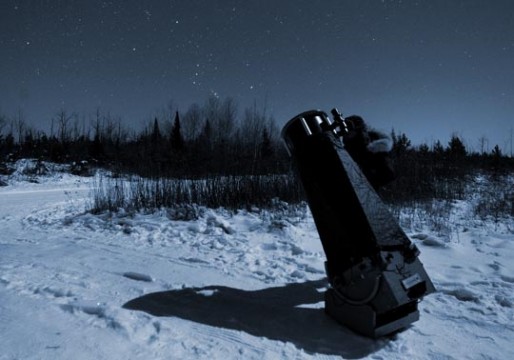
Bob King
Okay, so much for overall color. What about individual colors under a full Moon? You may have read that colors aren't perceptible in moonlight, but experiments during both summer and winter (with and without the bump from snow) prove the contrary, at least to this pair of eyes.
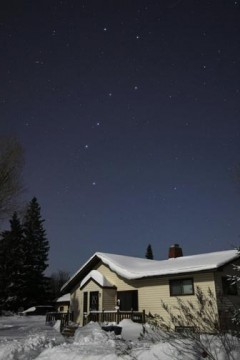
Bob King
During last month's full Moon, which stood high in Taurus, I could see the red of a stop sign without difficulty. Ditto for my green coat and the tall, brown weeds covering a nearby field. I only struggled with blue, which looked unusually pale, verging on white in the lighter hues and grey in the darker. While none of the colors jumped out, I saw each convincingly. At least around the time of full Moon, there's enough light to activate the eye's cones, contrary to common belief.
Granted, there are individual differences in visual perception depending on your particular set of cones and rods, but it's fascinating nonetheless to see how far you can expand your nighttime vision by conducting these simple experiments. If nothing else, you'll get a walk in the moonlight as reward for your efforts.
What will you see as the Moon goes a for high ride in Gemini this weekend? Is the landscape really blue? How clearly do specific colors stand out? Please drop us a line in Comments and share your perspective.
* Note: To access the paper described above, scroll to the bottom of the page link and click on "View". Depending on your browser, the "View" button may also be located in the right panel of the web page.
Feeling Moonstruck? Use the Sky & Telescope Moon Globe to sort yourself out!
 3
3
Comments
Mac Wiley
January 5, 2015 at 10:04 am
Cold hearted orb that rules the night,
removes the colours from our sight.
Red is grey, and yellow, white,
but we decide which is right,
and which is an illusion.
Late Lament by Graeme Edge
(Poem from the beginning & end of The Moody Blues "Days of Future Passed",
usually associated with "Knights in White Satin".
You must be logged in to post a comment.
Bob KingPost Author
January 7, 2015 at 12:05 am
Hi Mac,
Oh my, that brought back memories. Loved that song. Thanks!
You must be logged in to post a comment.
Bob KingPost Author
January 17, 2015 at 1:54 am
Mac Wiley - how perfectly appropriate! Plus those lyrics bring back memories.
You must be logged in to post a comment.
You must be logged in to post a comment.